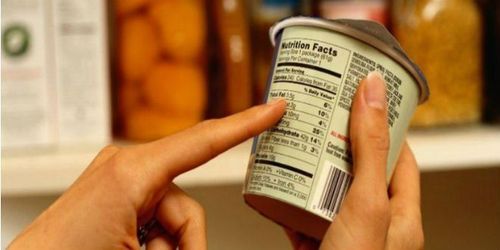This is an automatically translated article.
The body does not need to get any more carbohydrates from sugar. That is shown right on the nutrition pyramid of a healthy diet with a very low daily sugar content. Besides, good control of sugar in the diet will bring many health benefits.
1. Sugar in the diet
The average American consumes 22 teaspoons of added sugar per day, which equates to 350 calories. Although we sometimes add sugar to our foods ourselves, most of the added sugar in our diets comes from processed and processed foods. Sugary drinks and breakfast cereals are other great sources of added sugar. The American Heart Association (AHA) has recommended that Americans significantly cut back on added sugars to help slow the development of sugar-related diseases such as obesity and heart disease.
The American Heart Association AHA also recommends limiting added sugars including sugar in foods to a limit of no more than 100 calories per day (about 6 teaspoons or 24 grams of sugar) for most women. women and no more than 150 calories per day (about 9 teaspoons or 36 grams of sugar) for most men.
Sugar is not included in the nutritional requirements and there is no benefit in adding more sugar to the diet. A good rule of thumb to help control sugar levels in foods is to avoid products with a lot of added sugar, including omitting foods that list sugar as the first or second ingredient in products. However, the growing use of alternative sweeteners can make it difficult to determine which ingredients are considered sugar, as there are many sources of sugar with different names.
2. Some foods have added sugar
By food law, the nutrition facts label must list the number of grams of sugar in each product. But some foods themselves contain natural sugars, while others have added sugar in them.
2.1. Sugary drinks Soft drinks are a major source of extra calories that can contribute to weight gain and are not products that offer any nutritional benefits. Studies show that liquid carbohydrates like sugary drinks are less filling than solids. Because of that, it can make people who directly consume it continue to feel hungry after taking it despite their high caloric value. Furthermore, sugary drinks are also believed to be a contributing risk factor for the development of type 2 diabetes, heart disease, and other chronic diseases.
A medium can of sugary soda or fruit juice provides about 150 calories, almost all of which come from sugar, usually high-fructose corn syrup. The content of this ingredient is equivalent to 10 teaspoons of table sugar.
If you only drink one can of sugary soft drink a day and do not cut calories from other foods in your daily diet, you can gain up to 6.8 kg in three years.

Nước ngọt là sản phẩm không mang lại bất kỳ lợi ích dinh dưỡng nào
2.2. Grains and other foods Opt for whole-grain, unprocessed breakfast foods like applesauce, or a bowl of oatmeal... and a short grocery list will be a great way to Avoid adding sugar. Unfortunately, many processed and fairly common breakfast foods such as prepared breakfast cereals, cereal bars, flavored instant oatmeal and cakes can contain large amounts of sugar. complementary.
Some foods list the amount of sugar in the product's ingredients. To avoid using sugar as the first ingredient in a product, food manufacturers can use multiple forms of sugar, each with a different name, and list each form separately on the nutrition label. By using this tactic, lines are represented separately in smaller numbers. It is for this reason that it makes it difficult for consumers to determine the overall amount of sugar in a product and to make smart choices for these types of products.
Our body can metabolize all kinds of sugar added from the outside into the food or from the outside into the food processing process. It will even metabolize these sugars in the same way and there is no distinction between brown sugar or sugar from honey.... So to be able to choose the right foods as well as determine the function. sugar in your daily meal, it is important that you first read food labels carefully. It can help you discover the source of the sugar that is provided in the food, sometimes the sugar itself is not listed in the first ingredient of the food.
You can enjoy sweets in moderation, but make sure you're aware of the added sugars from other foods in your diet, such as breads, drinks and cereals. the cup.
3. How to spot foods with added sugar on food labels
Detecting extra sugar on food labels can require some pretty complicated work. Previously, food and beverage manufacturers in the United States were required to list the total amount of sugar per serving of a product in the Nutrition Facts Sheet, but they did not need to disclose details about the amount. Artificial sugar is added compared to the amount of natural sugar. However, this is set to change with the rollout of an updated Dashboard that will include additional sugar details along with a corresponding 10% Daily Value. Added sugar limit 50 grams (about 12 teaspoons) of added sugar for 2,000 calories daily is recommended for most adults.
Cách phát hiện thực phẩm có bổ sung đường trên nhãn thực phẩm
Ingredients are listed in descending order by weight. Therefore, where sugar is listed in relation to other ingredients can indicate how much sugar a particular food contains. Added sugars go by many different names, but they are all sources of extra calories in foods used on a daily basis.
Food manufacturers may also use sweeteners that are not technical sugars. This is a term applied only to table sugar, or sucrose, but these other sweeteners are in fact added sugars. Here are some other names for sugar that you may see on food labels: Agave nectar, cane juice concentrate, malt syrup, brown sugar syrup, fructose, cane crystals, fruit juice concentrate, Molasses, cane sugar, glucose, raw sugar, corn sweetener, high-fructose corn syrup, sucrose, corn honey syrup, fructose crystals, invert sugar, dextrose maltose.
Please dial HOTLINE for more information or register for an appointment HERE. Download MyVinmec app to make appointments faster and to manage your bookings easily.
Reference source: hsph.harvard.edu












